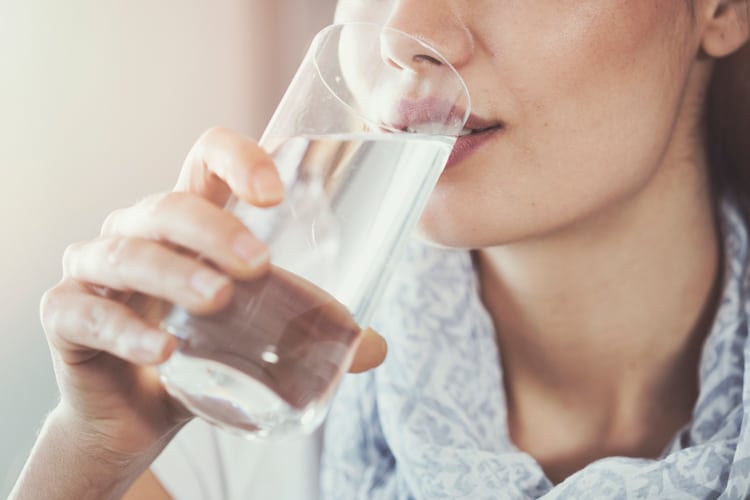Strategies for Treating Dry Mouth
Saliva plays an important role in protecting the oral cavity, supporting health, and maintaining balance in the oral environment.

Importance of Saliva
Saliva plays an important role in protecting the oral cavity, supporting health, and maintaining balance in the oral environment. Secreted by major and minor salivary glands, saliva is composed of 99% water and 1% organic and inorganic molecules. The right quantity and quality of saliva are important to the proper lubrication of the oral cavity. Saliva also assists in cleaning the oral cavity, balancing the demineralization/remineralization process, and improving taste and digestion. Reduction in the quantity of the salivary flow leads to dry mouth, while xerostomia refers to the perception of dry mouth with or without an actual decrease in salivary flow levels.
Photo Credit: SensorSpot / E+

Detection of Dry Mouth
A detailed medical and dental health history is essential to early detection of dry mouth and identification of potential underlying causes. When performing an oral examination on those complaining of dry mouth symptoms, dry and friable oral mucosa and dry and fissured tongue may be present. However, patients may experience a 50% loss in protective saliva before they notice dry mouth symptoms.
Photo Credit: OnstOn / iStock / Getty Images Plus

Signs and Symptoms
Signs and symptoms of dry mouth include:
- Thick ropey saliva
- Dry mucosa in which the gloves stick to the mucosal surface during clinical examination
- Fissured tongue
- Atrophy of the filiform papillae
- Oral malodor
- Dysgeusia
- Glossodynia
- Cracking and fissuring of the oral mucosa
- Cracked, peeled, or atrophic lips
- Angular cheilitis
Photo Credit: Tharakorn / iStock / Getty Images Plus

Etiology of Dry Mouth
Dry mouth is caused by the following:
- Age
- Medication use
- Cancer therapy
- Sjögren syndrome
- Other conditions: Poorly controlled diabetes, sarcoidosis, hormonal changes (eg, pregnancy or menopause), salivary gland agenesis or aplasia, uncontrolled hypertension, hepatitis C virus infection, graft-vs-host disease, cystic fibrosis, human immunodeficiency virus/acquired immunodeficiency syndrome, lymphoma, nerve damage from a head or neck injury, surgical removal of salivary gland, psychogenic disorders, stroke, smoking, impaired fluid intake, vomiting, diarrhea, decreased mastication, and mouth breathing.
Photo Credit: Ridofranz / iStock / Getty Images Plus

Treatment Tips
The first line of defense in the treatment of dry mouth is patient education on lifestyle modifications. Patients should be encouraged to sip water throughout the day, suck on ice chips, use lip lubricants every few hours, and suck on sugar-free candy or chew sugar-free gum. Individuals with xerostomia should be advised to avoid caffeine, alcohol, tobacco, sugar-containing foods, salty or spicy foods, and dry, difficult-to-chew foods. The use of a humidifier at night to add moisture to the air may also be helpful. Patients with xerostomia should be advised to seek professional oral health care at more frequent intervals due to their increased risk for dental caries and periodontal diseases.
Photo Credit: seb_ra / iStock / Getty Images Plus

Prescription-Based Therapies
Secretagogues, such as pilocarpine and cevimeline, may help stimulate salivary function. However, the use of pilocarpine has some significant side effects, including increased heart rate, high blood pressure, sweating, cutaneous vasodilation, nausea, vomiting, diarrhea, increased urinary frequency, bronchoconstriction, and vision problems. For patients experiencing dry mouth due to cancer chemotherapy or head and neck cancer radiotherapy, the prescription medication amifostine has been shown to help prevent damage of the salivary glands.
Photo Credit: DNY59 / iStock / Getty Images Plus

Additional Approaches
Adding toothpastes, gels, and mouthrinses with a neutral pH and those containing carboxymethylcellulose to a patient’s oral hygiene regimen may also help mitigate symptoms. Toothpastes and mouthrinses with plant-based ingredients, such as coconut oil, can also help soothe dry mouth symptoms. Caries prevention is key among those with xerostomia, and prescription-strength fluoride dentifrices and mouthrinses should be recommended, in addition to the use of professionally applied fluoride. Modalities containing arginine bicarbonate and calcium carbonate may also help patients with xerostomia maintain a neutral pH in the oral cavity and support healthy enamel. Products with amorphous calcium phosphate (ACP), casein phosphopeptide-ACP (Recaldent), calcium sodium phosphosilicate (NovaMin), and tricalcium phosphate may also support remineralization and reduce caries risk. Incorporating a chlorhexidine mouthrinse in to the oral hygiene routine can help minimize dental plaque accumulation.

